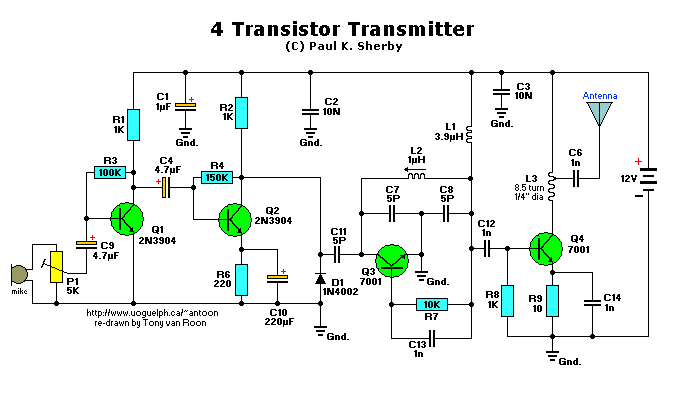
Parts List:
All resistors are 1/4 watt 5%
R1,R2,R8 = 1K C1 = 1uF/63V, electrolytic
R3 = 100K C2,C3 = 10nF, ceramic
R4 = 150K C4,C5,C9 = 4.7uF/63V, electrolytic
R5,R7 = 10K C6,C12,C13,C14 = 1nF, ceramic
R6 = 220 ohm C7,C8,C11 = 5pF, ceramic
R9 = 10 ohm C10 = 220uF/63V, electrolytic
P1 = 5K trimpot
Q1,Q2 = 2N3904 L1 = 3.9uH
Q3,Q4 = 7001, NTE123AP L2 = 1uH
D1 = 1N4002 L3 = aircoil, 8.5 turns air space
1/4 inch diameter
Circuit Notes:
This circuit provides an FM modulated signal with an output power of around 500mW. The input microphone pre-amp is
built around a couple of 2N3904 transistors (Q1/Q2), and audio gain is limited by the 5k preset trim potentiometer.
The oscillator is a Colpitts stage, frequency of oscillation governed by the tank circuit made from two 5pF ceramic
capacitors and the L2 inductor.
(Click here for Colpitts Oscillator Resonant Frequency Equation.)
Frequency is around 100Mhz with values shown.
Audio modulation is fed into the tank circuit via the 5p capacitor, the 10k resistor and 1N4002 controlling the amount
of modulation. The oscillator output is fed into the 3.9uH inductor (L1) which will have a high impedance at RF
frequencies.
The output stage operates as a 'Class D' amplifier, no direct bias is applied but the RF signal developed across the
3.9uH inductor is sufficient to drive this stage. The emitter resistor and 1k base resistor prevent instability and
thermal runaway in this stage.
Paul K. Sherby
Belleville,
Michigan.
USA
Website: Paul's Website
http://www.geocities.com/Eureka/Park/5323
Some substitutes for the 2N3904 are: NTE123AP, 2N4401, BC547(watch lead orientation), etc. The 7001 (Q2/Q3) oddly
enough also reference to the NTE123AP. Although the 2N3904 is very common and easily available. -Tony
Back to Circuits page
Page copyright © 1995, Tony van Roon
Article copyright © 2001, Paul K. Sherby

